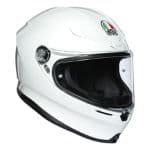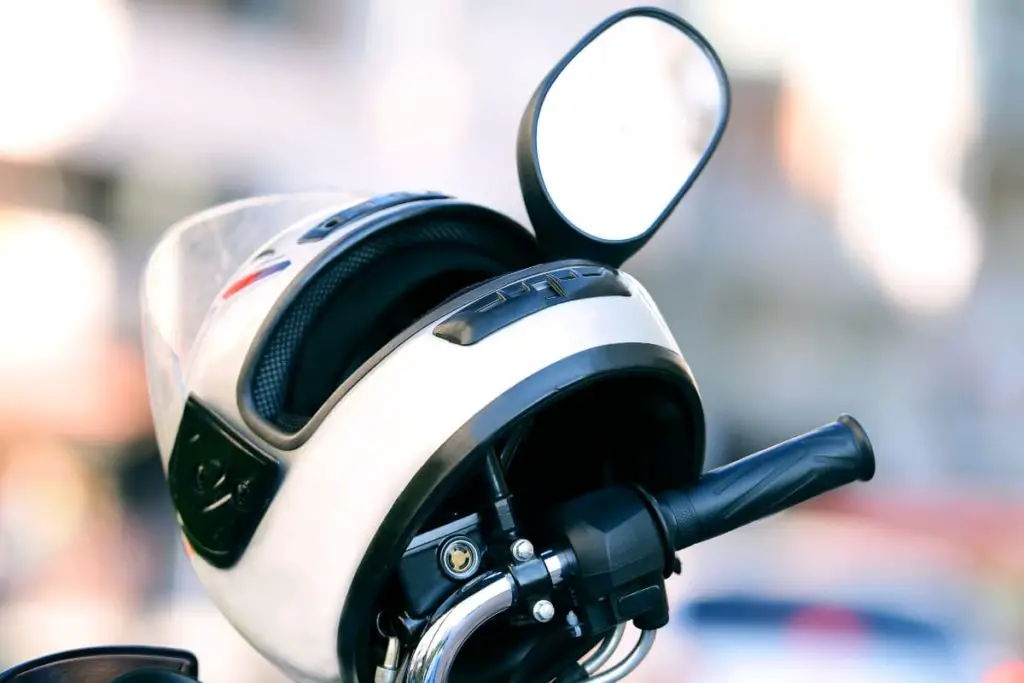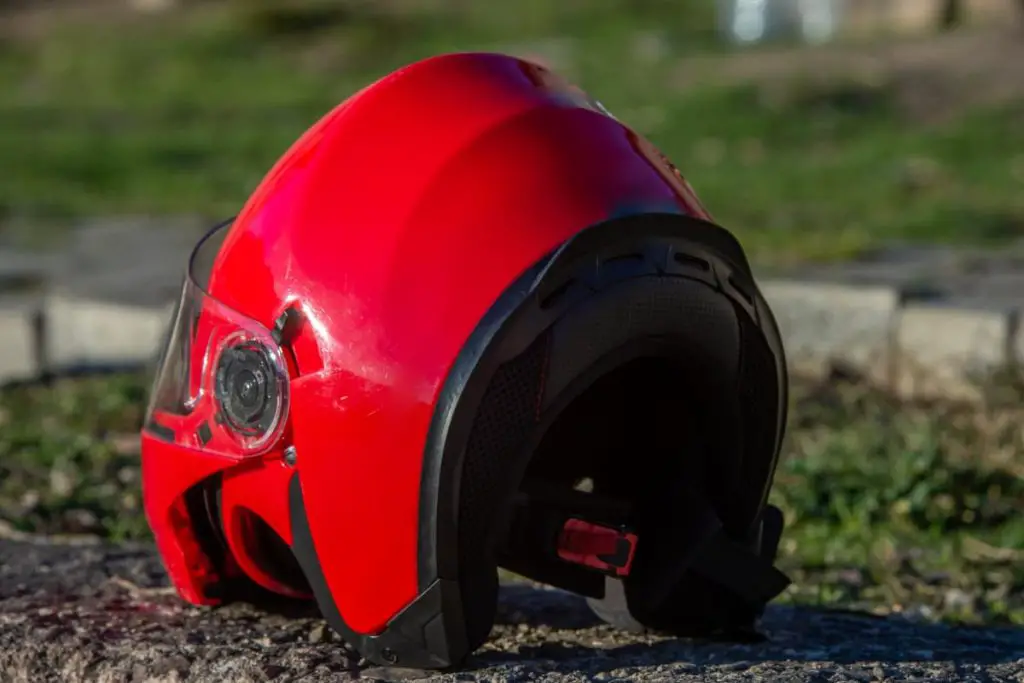There is nothing like traveling down an open road on your scooter or motorcycle. Just don’t forget your helmet! If you’ve been doing any riding, you probably already have one but then that begs the question: is it still good, or has it, for lack of a better word, expired? They can be quite expensive, so I totally get not wanting to replace your old helmet unnecessarily! How do you know when to replace your helmet?
In general, motorcycle helmets should be replaced every three to five years. If your helmet has been involved in any impact such as a drop or accident or shows signs of wear such as cracks on the exterior, condensed foam in the interior areas, then it needs to be replaced even if sooner.
That said, there are tell-tale signs to look out for. There is no sense buying one too soon, but I really, really want you to stay safe while out riding… Replace your helmet if it needs it!

Top Helmet Pick
Lightweight, breathable, & available in more than just black (for visibility & heat deflection)
Do Motorcycle Helmets Really Expire?
While helmets do not have a due date, many of the modern ones do have a manufactured date. You will conveniently find the manufactured date on a sticker on the inside of the helmet. This information can be found under the liner of your helmet.
Notice that it includes a suggestion from the manufacturer of when you should get a new helmet. However, on average it is suggested that you replace your helmet every three to five years.
But, this is not set in stone since many other factors can influence the wear and tear of your helmet.
The thing is that a lot can affect the lifespan of a helmet outside of aging, and like any product, time and frequency of use will wear it down. Therefore, it is a good idea to take your individual helmets use and wear and tear to determine if you need to consider a helmet replacement.
I’m a huge fan of

How Can I Tell if My Helmet is Damaged?
There can be some obvious details that indicate a new helmet is needed such as cracks, tear in foam, age, and how often you use it. When you look at the outer shell or comfort liner of your helmet, you should pay attention to how it looks. Does it look like it’s in good shape? That said, not all things that make a helmet unreliable can be seen with the naked eye!
Helmets have 3 primary layers to how your skull is protected. There is an outer shell, some sort of internal ‘styrofoam’ and a comfort liner.
Outer Layer
This outside shell is the outside that hopefully looks cool, but there should be no cracks or dings, no visible damage. In addition, older helmets can become brittle or weaken from too much UV light (aka sunlight) which adds to the brittle potential. A yellowish tint is also an indicator of an aging helmet. Even small cracks are a problem to the outer shell.
However, helmet manufacturers know about this issue, and they have added an inhibitor or stabilizer as either a primary resin or a special coating. It extends the protection and age potential of your helmet, but they still won’t last forever!
Crash Protection Foam (middle layer)
The foam layer is generally made up of Expanded Polystyrene foam (EPS foam), and there are some with Expanded Polypropylene (EPP) or Expanded Polyurethane (EPU). We don’t have to get into the weeds here, but this is a type of helmet technology that works to absorb the impact before it reaches your skull.
While some are more resilient and bounce-back better than others, any impact weakens the ability of the helmet to protect you like it does before any impact.
While an impact generally means a full-on crash, even a minor crash of just falling from the seat of your motorcycle or scooter is enough to damage this specialty helmet foam. You can check the this EPS liner when you remove the inner layer we’ll move to in just a moment.
Comfort Liner
The inner liner also known as the comfort liner is the part that helps the helmet fit snugly to your head, comfortably. This interior foam seems to age the fastest as this foam gets neglected with body oils and hair product at a minimum plus it gets squished by just wearing it, especially with years of use – even minimal use!
These foam liners get nasty and can start smelling badly, so when you wash it to take good care of your helmet, it is a good time to do an overall inspection to make sure it isn’t damaged.
Remove the comfort liner, wash as indicated by your manufacturer, wipe down the shell (again according to the manufacturer), and then give it a thorough inspection!
The other main signs that your helmet is damaged can be more subtle such as (source):
- The helmet feels loose. This can be due to foam padding getting worn down due to heavy use. To test this all you would have to do is to put on your helmet, tighten it and shake your head around. If it moves it has become too loose even if you didn’t notice this in your visual check..
- Chin straps are not as they once were. They can fray, stiffen, or tear. Plus, the metal bit that holds everything together can also get rusty. Each pieces keeps the helmet attached to your head in case of an accident, so you can’t afford for any part to fail!
- Comfort, padding, and EPS/EPU foam have gotten hard and no longer gives you comfort. Push gently on each component. If you stay on top of checking, it should become more obvious if something chances here.
But, there are replacement parts for the helmets so that you would not have to get a whole new one. However, if you have had your helmet forever, it may be best to be safe then take the “cheap” way out. Safety is your top concern.

Replace Your Helmet if Any Impact Occurs
If your helmet has been impacted by a crash, you must replace it even if it looks and feels fine.
Don’t let this freak you out. Some manufacturers such as Bell have a policy to give you a nice discount to encourage you to replace your helmet.
The reasoning for this is that many helmets are made from foam that is for “one-time-use” only. Therefore, if you hit your head in the helmet then the foam will no longer give you as much protection.
So, if you see any signs of crack or the foam is not as it was, the best is to get a new helmet.
Even if you did not feel the impact of a crash does not mean your helmet did not. Most helmets are made up of a special foam (EPS or EPU). The sole purpose of the foam is to absorb impact, BUT the foam can only absorb so much impact.
While not visible, any type of impact – whether a drop from a table or a real crash – means it will not be able to protect your head in the same way as an undamaged helmet.
Some manufacturers such as Shoei offers a free inspection service if you’re up for mailing it in to make sure it remains in good condition. heck out the brand of your helmet. I’ve been surprised by the length some go to help you stay safe!
How Do I Know if MY Helmet is Still Good?
Now, let’s say that you did not get into a crash and that everything in, around, and on your helmet is tight and working. But, it is drawing to the five years mark so how can you tell if it is still actually good?
Well, you can ask yourself some questions such as (source):
- Has your helmet been touched by any type of chemical? When we say chemicals we do not mean the dangerous, toxic ones, but instead the everyday ones like sunscreen and even glass cleaner like Windex. Sweat does not really count since modern, newer helmets are designed to withstand normal wear.
- Where do you keep your helmet when not in use? For example, has it been sitting in sunshine that comes through the window? Is it getting heat from sitting next to something in the garage that stays pretty warm?
- How does the helmet look and feel? If it is uncomfortable or loose and you cannot tighten it or it has cracks and scratches outside AND inside, then get a new helmet. There are plenty of affordable options, and any crack means your helmet won’t protect you the way it would when you first bought it! Check out this guide if you need some insight into the average cost of different helmet styles.
- How old is it? Now we mean is it from the 80s, 90s, and is vintage? Now that is cool! That said, keep it on display. Skip using it for rides.
If you check your helmet on a regular basis, you’ll likely be aware of any issues that develop. I want you to be safe and have a good time when you ride, so we whole-heartedly suggest that you replace your helmet if you have any doubt at all. Another way to stay safe is by traveling with peace of mind, after all!

What’s Next?!
The important thing to do is to pay attention to how often you use your helmet. If it is often used then it is more subject to sunlight, wear, and tear.
Always check the foam of your comfort liner & the foam liner under it.
Don’t forget to check the manufacture date sticker. Usually, it is three to five years depending on the amount of use and how it’s been treated.
If the padding, straps, or there are cracks anywhere in and on the helmet then it would be best to replace it. Replacement parts are an option, but make sure that they are attached well and as intended.
If it has been in an accident, then it is done and you have to get a new one. Regardless of how it looks and feels. There was a lot of internal damage done to it that it lost its shell bounce, the padding is dead and it is not safe anymore. Cut & dry.
Overall, it is better to get a new helmet if you have any doubts or worry about your old one. When riding you need a clear head and worrying about your helmet’s safety quality will not give you that.
You will get more ‘life’ out of your helmet so to speak if you store it well, so read here for ways to store your motorcycle helmet to keep it pristine.
Tips to clean your motorcycle helmet will also help in that regard (& keep it from being smelly).
Resources
It’s important to learn from your own experience, but let’s speed up the learning curve by learning from others along the way. These are sources used in this article, in addition to, our own personal research to provide you the best resource!
When to Replace a Helmet? (n.d.). https://helmets.org/replace.htm.
Z, T., R, R., & G, M. (2019, May 22). What Material Choices Are There in Motorcycle Helmet Construction? MOTORCYCLEiD.com. https://www.motorcycleid.com/articles/what-material-choices-are-there-in-motorcycle-helmet-construction.html.
